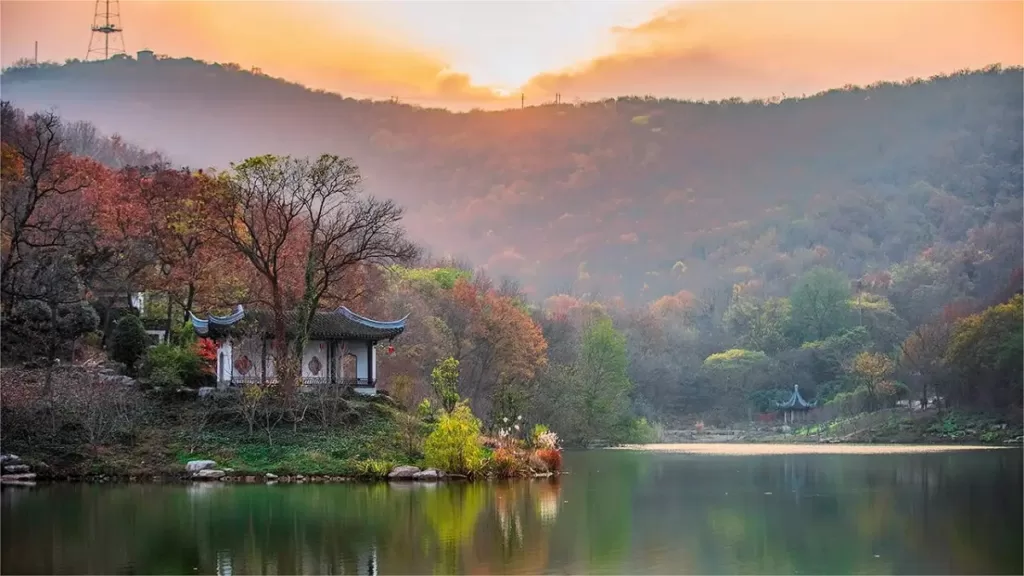Nanshan National Forest Park, Zhenjiang - Eintrittskarten, Öffnungszeiten, Lage und Highlights


Nanshan National Forest Park (南山国家森林公园), located in the southern part of the city of Zhenjiang, is a picturesque expanse covering approximately 1000 hectares. Situated 2.5 kilometers from the city center, the park encompasses renowned peaks such as Zhaoyin Mountain, Huanghe Mountain, Jia Mountain, and Jiuhua Mountain. The region experiences a transitional monsoon climate from the North Subtropical Zone to the Warm Temperate Zone, with an average annual temperature of 15.4°C, ranging from a minimum of -12°C to a maximum of 40.9°C. The average annual precipitation hovers around 1074 millimeters, contributing to a lush environment with a 73% forest coverage.
Nanshan National Forest Park holds historical significance, attracting admiration from literary figures since the Southern Dynasties. Notable personalities like Xiao Tong, the compiler of “Zhaoming Wenxuan,” Liu Xie, the author of “Wenxin Diaolong,” the artist Dai Yun, the poet Su Dongpo, and the founders of the “Mi School of Clouds and Mountains” painting style, Mi Fei and his son Mi Youren, have all left their mark on this landscape. Renowned individuals such as Liu Yu, the founding emperor of the Southern Song Dynasty, once engaged in activities like chopping wood, fishing, and selling straw sandals in this area.
Inhaltsübersicht
- Grundlegende Informationen
- Standort und Transport
- Highlights of Nanshan National Forest Park
- Nützliche Tipps aus Rezensionen zusammengefasst
- Other Natural Scenery in Zhenjiang
Grundlegende Informationen
| Geschätzte Dauer der Tour | Ein halber Tag |
| Ticketpreis | 40 RMB (1st March – 31st May and 15th August – 30th November) 30 RMB (1st June – 14th August and 1st December – 28th February) |
| Die Öffnungszeiten | 7.30 – 17.30 |
| Telefon Nummer | 0086-0511-84498660 0086-0511-84423090 |
Standort und Transport
Nanshan National Forest Park is situated in the southern part of Zhenjiang City, Jiangsu Province, China. The geographical coordinates of the park range between 119°25′00″ to 119°27′30″ East longitude and 32°8′ to 32°11′ North latitude. Positioned as an extension of the Yuzhen Mountain Range, the park is nestled in the undulating landscape of the region.
To get there, tourists can take bus 67, 86, 113, or 218 and get off at Nanshan West Entrance Stop (南山西入口站).
Highlights of Nanshan National Forest Park
Crane Forest Temple (鹤林寺)

Nestled at the northern foot of Moji Mountain, Crane Forest Temple is a renowned ancient temple with a history spanning over a millennium. Originally named Bamboo Forest Temple, it was founded during the Eastern Jin Dynasty (318-321 AD). Legend has it that during a visit by Emperor Wu of the Southern Song Dynasty, Liu Yu, cranes danced above the bamboo forest, prompting the emperor to rename the temple as Crane Forest Temple. The site bears witness to the rich historical tapestry of the region.
Zhao Yin Temple (招隐寺)

Dating back to the first year of the Jingping era (432 AD) in the Southern Dynasty, Zhao Yin Temple boasts a history of over 1500 years. Originally the private residence of the renowned sculptor and musician Dai Yun, it was later converted into a temple by his daughter, who vowed not to marry. The temple has experienced cycles of prosperity and decline, surviving destruction during the Taiping Rebellion and subsequent rebuilding during the Qing Dynasty, only to face further damage during the Sino-Japanese War.
Tiger’s Leap Spring (虎跑泉)

The legend of Tiger’s Leap Spring dates back to the time of Prince Zhaoming, who faced difficulty finding water during his early visits to Zhaoyin Mountain. One day, as he encountered a tiger on the mountain slope, the tiger, in its attempt to attack the prince, left behind a deep pit with clear spring water. Delighted, the prince named it “Tiger’s Leap Spring.” The spring, now housed in a square well, provides clear water suitable for brewing tea. The surrounding area includes the “Eternal Green Pavilion,” formerly known as “Tiger’s Leap Pavilion,” and a stone inscription by Cheng Xun, the magistrate of Zhenjiang, during the Ming Jiajing period.
Bamboo Forest Temple (竹林寺)

Situated in the midst of Jia Mountain, Bamboo Forest Temple, also known as Jia Mountain Zen Temple, has a unique charm with its setting amid dense bamboo groves. It was established by the Zen master Fa’an during the Eastern Jin Dynasty. The temple, characterized by its five-layered structure connected by stone steps, providing a serene and contemplative atmosphere. The presence of ancient stone inscriptions and the historical connection to renowned figures contribute to the temple’s cultural significance.
Nützliche Tipps aus Rezensionen zusammengefasst
Stick to Main Paths for Safety: Nanshan National Forest Park has many trails, and for those unfamiliar or exploring alone, it is advisable to stick to the main paths for safety reasons. Prioritize safety over exploration in less familiar areas.
Protect Against Mosquitoes: Be sure to take precautions against mosquitoes as there are areas with a significant mosquito presence. Using insect repellent and wearing appropriate clothing can help make your visit more comfortable.
City Park Atmosphere: Some reviewers liken Nanshan to more of a city park than a traditional scenic area. Most attractions within the park are newly constructed artificial facilities, providing a setting more suitable for leisurely walks and casual strolls rather than offering high scenic appeal.
Other Natural Scenery in Zhenjiang

Baohua Mountain National Forest Park – Source of Qinhuai River

Maoshan Mountain – Birthplace of Shangqing School of Daoism
Jiangsu-Landschaft, Zhenjiang Attraktionen